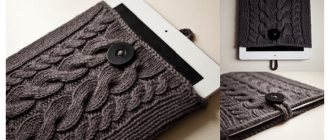QUESTION! How do wireless headphones work?
ANSWER! Wireless headphones for phones operate on Bluetooth technology, which allows you to transmit information over a short distance using radio waves. When you connect your phone to headphones, it in turn transmits sound information to the receiver, which then plays sound to small speakers. For Bluetooth to work, both devices (receiver and transmitter) must have the appropriate module. And now in more detail...
What are wireless headphones
Wireless headphones (Head Set, headphones) are a pair of small devices that are mounted on the head or inserted into the ears and receive a signal from a source wirelessly. If the device is combined with a microphone, then this accessory is called a wireless headset.
To receive a signal from an electronic device “over the air” there are 2 ways:
- using radio waves;
- through radiation in the infrared range.
The operating principles of infrared headphones and the TV remote control are very similar.
A transmitter with an infrared LED is connected to the source; it transmits an audio signal using a coded high-frequency pulsation of light to the receiver built into the Head Set.
Previously, IR headphones were purchased to watch TV in the evening, but they are outdated due to:
- inability to work in good lighting;
- short range of the transmitter;
- the receiver is in line of sight.
Unlike infrared headphones, devices operating on radio waves are improving and gaining popularity.
Bluetooth
Bluetooth was named after Harald Bluetooth, who united the Scandinavian lands, and thus went down in history. In this case, technology unites and allows phones, tablets, laptops, TVs, headphones and speakers to communicate.
The principle of operation is simple - there is a receiver and a transmitter, and information is transmitted using radio waves. In this case, a special ISM frequency range is used from 2.4 to 2.4835 Hz. The range was not chosen by chance - after all, it is the one that does not need to be licensed in most countries of the world. It is used in industry, science, medicine and other fields.
Transmission uses spread spectrum method. I won’t go into details, since it’s not particularly necessary. Let me just say that this method allows you to use inexpensive equipment and also helps reduce the possibility of interference.
And interference can occur anywhere, because around us there are many, many other radio waves that operate in the same spectrum. These include: Wi-Fi, microwave ovens, radio, television, mobile and satellite communications and much more. This is precisely the spread spectrum method that helps not to overlap with the same frequencies and transmit data without loss or interference.
What are Bluetooth headphones? These are wireless headphones in which audio information is received using special protocols that allow you to send data in a stream. Since the device operates wirelessly, it uses a lithium-ion battery during operation, which needs to be charged periodically.
How they work on phones and other devices
Most modern wireless headphones use radio waves to operate, but they differ.
Bluetooth headphones
Bluetooth (translated from English as blue tooth) is the name of a manufacturing specification that enables the exchange of information between various devices.
To operate a Bluetooth headset, you do not need a transmitter, since most transmitting devices support Bluetooth.
In a chip built into an Android or laptop, the audio signal is encrypted, compressed and converted into radio waves.
In the Bluetooth receiver installed in wireless headphones, this radio signal is deciphered again into sound waves.
Despite the emergence of new versions of Bluetooth, headphones have disadvantages:
- they cannot work without a battery, and therefore their autonomy will be limited;
- synchronization requires a certain time;
- Although the range of action increases with each version of Bluetooth, the reception range greatly depends on the obstacles in the path of the signal;
- when a gadget and a device work together, an older version of one of them will be used;
- To listen to high-quality music, you need the aptX HD codec on the headphones and transmitting device.
TWS headphones
TWS - True Wireless Stereo, which translated from English means “truly wireless stereo.”
TWS headphones differ from other Head Sets in that the left and right ones are connected not by wire, but via Bluetooth.
To operate this gadget, the chips of the left and right earbuds are first connected to each other, and only then synchronization with the transmitting device occurs.
Well-known models of TWS headphones are AirPods and AirPods Pro, released by Apple with the W1 microprocessor, which allows:
- use power economically;
- instantly synchronize the headset with each other, the charging box and the transmitting device;
- ensure the operation of control sensors.
With NFC module
NFC (Near Field Communication is translated from English as “near field communication”) is a technology that allows you to establish a fast connection and data transfer between two operating devices when they are in close contact.
NFC modules installed in smartphones were originally designed for fast payments.
However, if the same module is installed in wireless headphones, then two different NFC and Bluetooth technologies can work together.
Thanks to the first, the connected device can be quickly determined, and only then data is transferred for the Bluetooth connection.
Wifi headphones
Wi Fi and bluetooth headphones are the same thing. The fact is that both technologies are part of the work of the IEEE 802.11 standard.
Therefore, any devices that have passed testing by the Wi Fi Alliance have the right to wear its logo.
Marketers took advantage of this, and as a result, the alliance trademark appeared on the box with a wireless headset instead of Bluetooth.
Of course, this should interest the consumer and attract them to purchase this product.
Creating Wi-Fi headphones is possible, but it makes no sense, because it will no longer be a gadget, but a device.
DIY wireless headphones
If you have an accumulation of broken electronic junk at home that you hate to throw away, then this article is just for you.
All the component materials were given to the author of the homemade product completely free of charge, and for this reason you will only benefit. Once upon a time the author had Explay headphones and a Prolife BT55 stereo Bluetooth headset. In the picture you can see that the headphones were missing some of the wires, and the headset was making wheezing sounds, that is, the speakers were completely faulty.
For this very reason, the author came up with the idea of making two not fully working things into one, but very necessary and performing its functions well.
First of all, let's sort everything out. We didn’t even need a screwdriver for this operation, because all the fasteners are ordinary latches.
You need to remove the remaining wires from the headphones, unsolder the speakers from the headset and remove the battery for a while. We do this so that it is possible to get the wiring; it is located in the headphone housing.
As a result of the manipulations done, the headset only has a block with buttons and internal contents.
Next we need to attach the block with buttons to our existing headphone body. This is done very easily.
After the cover has been removed, you can see that the space underneath is identical in diameter to the existing button block.
The last task at this stage is just to remove the wiring.
After we have separated the internal contents, we process the entire body so that it matches the size of the lining. Let's try this on the body of the existing headphones.
Next, you need to unsolder the mini-usb socket intended for the charger, and the author figured out how to make a small adapter from this socket to the socket that previously belonged to a Nokia mobile phone.
It turned out that the socket fit perfectly into the small hole that was previously intended for the wire.
Next, you need to make a small hole for the microphone using a drill.
After installing the board in place and securing it and the accompanying parts in place using hot glue, what came out was what you can see in the picture.
This photo is from the front. Here the author made a small mistake. It’s just that when he was drilling holes for the microphone, it turned out that he slightly touched the body with the cartridge.
As soon as the glue has hardened, we immediately attach the speaker itself using a soldering iron, and after that we close the case.
Next, you need to use a soldering iron to attach the second speaker, as well as the battery.
Well, finally everything is soldered and you can snap the case into place. Now let's put the foam rubber pads in place and put them on charge in order to carry out the test.
The check shows us that the indicator lights up red, which means everything is working.
Due to the fact that these headphones are regulated using a wire, the author decided to leave everything as it is. The only thing you need to do is throw the wire behind your head while the headphones are on. The sound in the headphones has become much better and even much stronger than the headset had before. The buttons, as well as the microphone, perform their functions perfectly, which is good news.
Source
Become the author of the site, publish your own articles, descriptions of homemade products and pay for the text. Read more here.
The principle of operation of radio headphones
A radio transmitter is connected to the electronic device, which transmits an analog signal to the receiver in the headphones using FM waves.
This method has its advantages:
- connection range up to 150 m, which is minimally affected by obstacles;
- instant connection between the headset and the transmitting device;
- natural sound of musical compositions.
- But there are also disadvantages:
- the design is not mobile, as it has a radio transmitter;
- the occurrence of interference, extraneous signals;
- radio communication does not save energy consumption;
- Communication operation is not protected by anything.
Wireless Headphone Features
Wireless Head Sets, in addition to receiving signals over the air, have expanded functionality.
Advanced TWS headsets in this regard have the following additional features:
1. Auto-connection. After the first pairing of the headset with the device, subsequent ones are performed automatically. To do this, just take the gadgets out of the charging box next to the smartphone with Bluetooth enabled.
2. Autopause. If one of the headphones is removed or falls out of the ear, the optical sensor is triggered and the track playback is paused. When the earphone is returned to the ear, the user can start listening to music from the interrupted place.
3. Touch or button control. Touch plates are installed on the outside of the earbuds or plugs, buttons are installed, or accelerometers are placed inside the case, with which you can stop, start and switch tracks, as well as adjust the volume level.
4. Headset. Each ear monitor has one, and sometimes two, microphones built into it, which allows you to answer an incoming call while listening to music without taking your phone out of your pocket.
5. Noise reduction. Additional microphones in each of the headphones allow external noise to be transmitted to an electronic device, which produces an anti-phase signal. When put together, they cancel each other out, which allows you to get rid of extraneous sounds not only when listening to music, but also during a telephone conversation.
6. Voice assistant. Anytime you pause a track, talk to Siri. You can give the voice assistant not only commands on the settings of a musical composition, but also ask questions.
7. High-speed charging. In order for the headphones to work for three hours, it is enough to place them in the charging box for 15 minutes.
8. Wireless charging. For example, the AirPods 2 charging box does not need to be connected to the device or power adapter with a special cord; wireless charging is already built into it.
9. Multipoint. This feature allows you to use the headset with several devices at the same time.
Additional features of modern headphones
Modern headphones can not only receive an audio signal and reproduce it in the user’s ears. Many manufacturers add additional functionality.
- Microphone – you can not only listen to music, but also chat with your friends on the phone.
- Auto-connection is available on almost all smartphones. Once connected, the phone remembers the device, and you no longer need to pair it again; you just need to turn on the headset.
- Autopause - if you remove at least one earphone, the song will stop playing.
- Controls - some headphones have buttons that can be used to pause, switch songs, or increase the volume. Buttons can be either physical or touch.
- Wireless charging – the headphones and case are charged without connecting wires, but this requires a special station. In details…
Functionality may vary depending on the model. In any case, the most important thing, in my opinion, is convenience and sound quality. I advise you to look at our TOP wireless headphones here.
Comparison table of audio transmission technologies
| Options | Radio | Bluetooth | TWS | With NFC module |
| Mobility | – | + | + | + |
| Connection speed between device and gadget | + | – | – (except for those with W1 chip from Apple) | + |
| Transmission range over 100m | + | – | – | – |
| Energy saving | – | + | + | + |
| Signal security | – | + | + | + |
| Multipoint technology | – | + | + | + |
Recommendations for choosing technology
When choosing a technology, decide where it will be used.
So radio headphones are better suited for movie watching users and gamers.
In the first case, this is due to the undemanding nature of high sound parameters, in the second - the absence of a delay between video and audio.
Sony has released wireless headsets for the PlaySаtation 4 with radio modules, not bluetooth.
When choosing Bluetooth headphones, pay attention to the following:
- Music lovers are better off choosing full-size headphones;
- for work - in-ear with Multipoint function;
- Head Set with active noise reduction is suitable for traveling on public transport;
- for sports - headphones with special clips that hold them firmly on the head, and also have moisture and dust protection.










